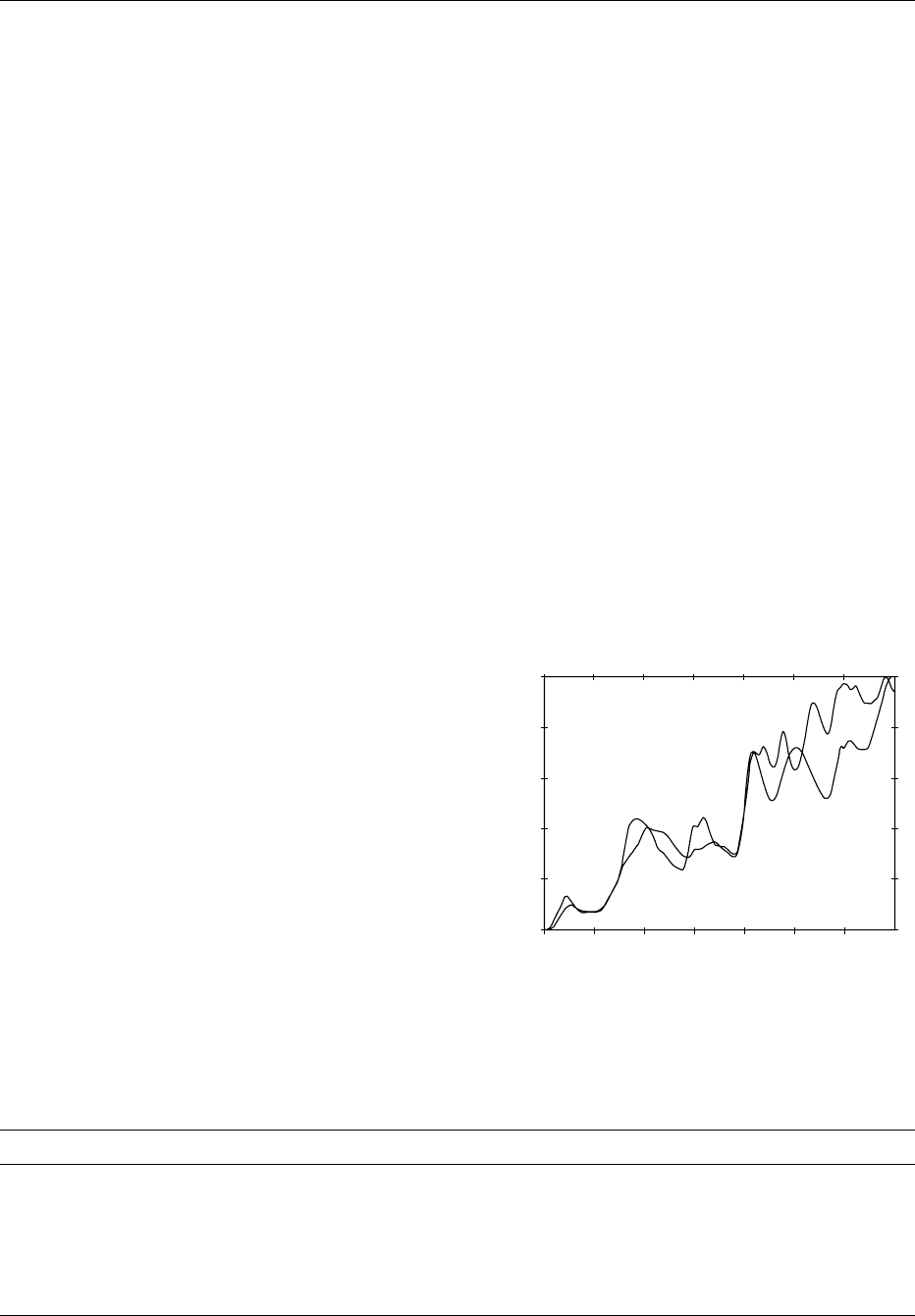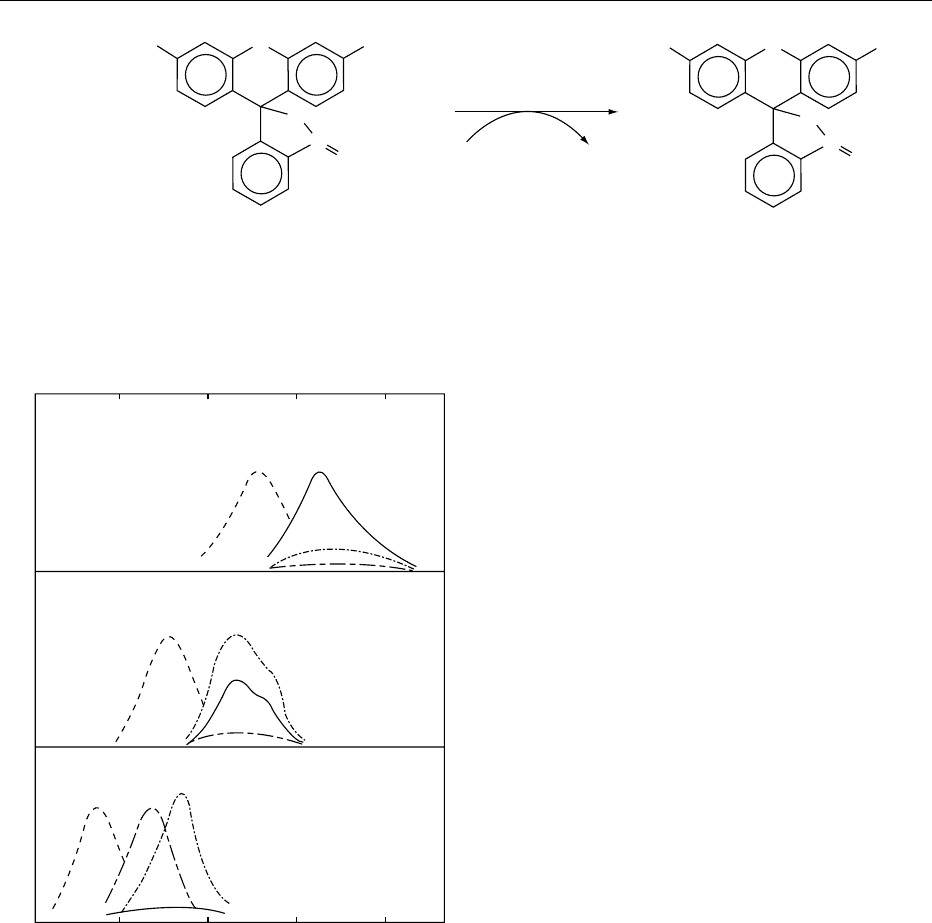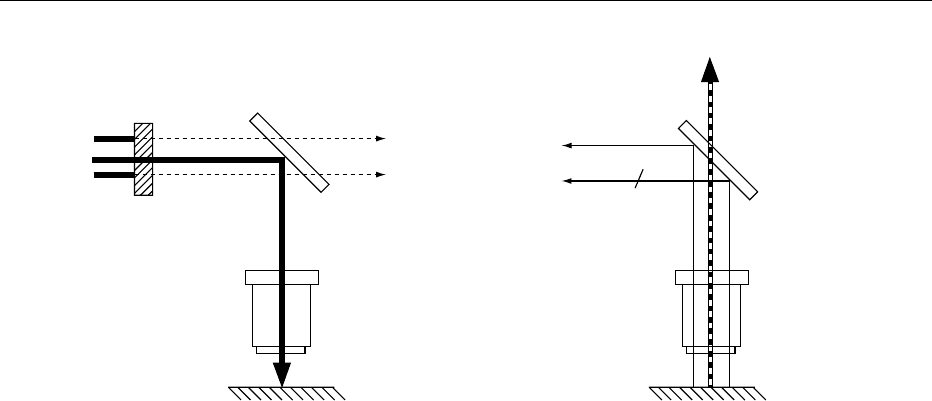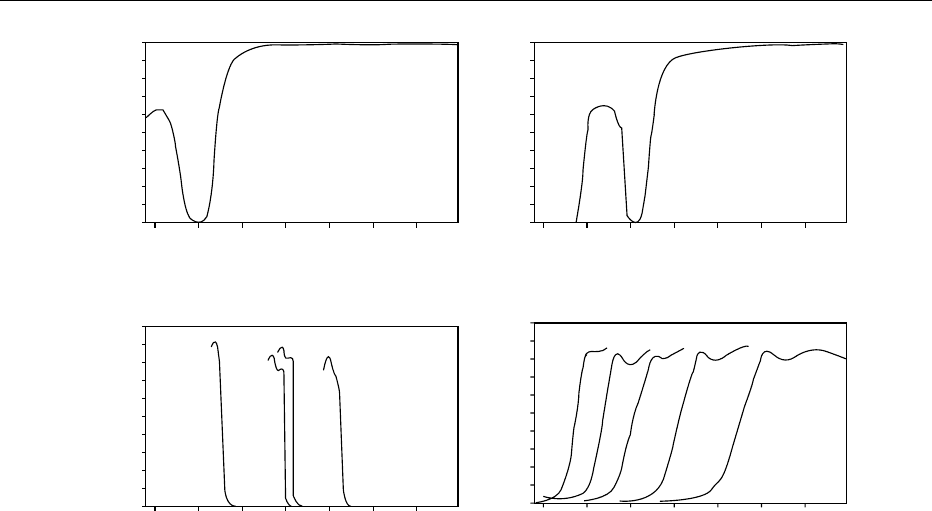Caballero B. (ed.) Encyclopaedia of Food Science, Food Technology and Nutrition. Ten-Volume Set
Подождите немного. Документ загружается.


commodities were introduced in the early 1970s.
These instruments were dedicated primarily to the
determination of moisture, protein, and oil in grains
such as wheat, barley, and soybeans. In the interven-
ing years, rapid advances in optics, digital electronics,
and computer technology have greatly improved the
reliability of the technique, as well as making it pos-
sible to analyze a much larger range of constituents in
a wide array of products.
Origins of Spectra
0005 A molecule can absorb infrared radiation if it vibrates
in such a way that its charge distribution, and there-
fore its electric dipole moment, changes during the
vibration. A vibrating molecule, or molecular func-
tional group, can absorb radiant energy to move
from the lowest (ground) state to its first excited
state. The frequency of radiation that will make this
occur will be identical to the initial frequency of vibra-
tion, and is referred to as the fundamental absorption.
Typically, fundamental absorptions have frequencies
that fall in the midinfrared region of the electromag-
netic spectrum (4000–650 cm
1
, wavelength ¼2.5–
15 mm). Molecules can also absorb radiation to move
to a higher (second or third) excited state, such that the
frequency of the radiation absorbed is two or three
times that of the fundamental frequency. Such absorp-
tions are referred to as ‘overtones,’ and the intensities
of these absorptions are much lower than the corres-
ponding fundamental, since these transitions are less
favored. Combination bands can also occur if two or
more different vibrations interact to give bands with
frequencies that are sums of their fundamental fre-
quencies. Combination and overtone bands typically
have frequencies that fall in the NIR spectral region.
0006 Both the overtone and combination bands ob-
served in the NIR tend to be weak in intensity. How-
ever, this is actually an advantage, since absorption
bands that have sufficient intensity to be observed in
the NIR region arise primarily from functional groups
that have a hydrogen attached to a carbon, nitrogen,
or oxygen atom. These are common functional
groups in the major constituents of food, including
water, proteins, lipids, and carbohydrates. The NIR
absorption bands associated with a number of im-
portant food constituents are listed in Table 1. The
NIR absorption bands of many foods frequently over-
lap, yielding spectra that are quite complex. This can
be illustrated by observing the spectra of the starch
and zein (protein) components isolated from corn
(maize) shown in Figure 1. The protein fraction
exhibits absorption bands centered at about 2050
and 2180 nm, whereas starch has a strong absorption
band centered at 2100 nm. Note, however, that there
is significant overlap of the starch band into the
regions where protein absorbs. Because of such over-
laps, quantitative analysis of most foods requires
measurements to be made at multiple wavelengths
in order to relate the amount of a constituent present
to the spectral measurement.
Principles of Diffuse Reflectance
Measurements
0007One of the advantages of NIR spectroscopy is its
ability to take measurements directly on solid food
Wavelength (nm)
1900
1100 1300 1500 1700
2100 2300 2500
0.467
0.365
0.264
0.163
0.061
−0.040
Log 1/R
Starch
Zein
Corn fractions
fig0001Figure 1 Near infrared reflectance spectra of the starch and
zein (protein) components of corn (maize).
tbl0001 Table 1 Absorption bands for important food constituents
Constituent Absorber Wavelength (nm)
Protein, peptides Amide I, II, and III combinations 2050–2180
—N—H stretch first overtone 1520–1570
Carbohydrate C—O, O—H stretching combination 2060–2150
Lipid Methylene —CH stretch þ deformation combination 2300–2350
—CH
2
and —CH
3
C—H stretch first overtone 1690–1765
Water —O—H stretch first overtone 1400–1450
O—H stretch þ O—H deformation combination 1920–1950
SPECTROSCOPY/Near-infrared 5427

samples with little or no sample preparation. This is
typically accomplished by measuring the diffusely
reflected radiation as a beam of NIR energy is directed
on to the sample. When radiation strikes a solid or
granular material, part of the radiation is reflected
from the sample surface. This mirrorlike reflectance is
referred to as specular reflectance, and gives little
useful information about the sample. Most of this
specularly reflected radiation is directed back toward
the energy source. Another portion of the radiation
will penetrate through the sample surface and be
reflected off several sample particles before it exits
the sample. This is referred to as ‘diffuse reflectance,’
and the diffusely reflected radiation will emerge from
the surface of the sample at various angles through
180
. Each time the radiation interacts with a sample
particle, the chemical constituents in the sample can
absorb a portion of the radiation. Therefore, the dif-
fusely reflected radiation contains information about
the composition of the sample, indicated by the
amount of energy absorbed at specific wavelengths.
It should be noted that the size and shape of the
sample particles can affect the amount of radiation
that penetrates and escapes from the sample surface.
0008 In NIR spectroscopy, the intensity of the diffuse
reflectance from the sample is quantitatively meas-
ured at each wavelength of interest. The intensity of
radiation reflected from the sample is compared with
the intensity reflected from a nonabsorbing reference,
such as a ceramic or fluorocarbon material. Reflect-
ance (R) is calculated by the following formula:
R ¼ I=I
0
;
where: I ¼ the intensity of radiation reflected from
the sample at a given wavelength and I
0
¼ the inten-
sity of radiation reflected from the reference at the
same wavelength. Reflectance data are expressed
most commonly as log(1/R), an expression analogous
to absorbance in transmission spectroscopy. Various
mathematical transformations, such as derivatization
and scatter correction, can also be applied to the
spectra. Such treatments may help to remove spectral
differences that can occur due to variations in sample
particle size.
0009 Transmission measurements can also be made in
the NIR region, and this is often the method of choice
for liquid samples. A liquid can be placed in a quartz
cuvette, and the absorbance measured at the wave-
lengths of interest. Transmission measurements can
also be taken from solid samples, but generally only
in the 800–1100 nm range. In this wavelength region,
the absorption bands are higher overtones that are
very weak, allowing the radiation to penetrate through
several millimeters of a solid sample. The use of
transmission measurements can minimize errors that
could occur with reflectance measurements taken
from samples having heterogeneous surfaces.
Instrumentation
0010The radiation source in most NIR spectrometers is
a tungsten–halogen lamp with a quartz envelope,
similar to a projector lamp. Such lamps emit large
amounts of energy in both the NIR and visible regions.
Wavelength selection in many NIR instruments is
accomplished with a grating monochromator. These
may be scanning monochromator instruments where
a grating is used to disperse the radiation by wave-
length, and is then rotated to impinge a single wave-
length, or, more appropriately, a narrow band of
wavelengths, on to a sample at any given time. With
this arrangement, it may take several seconds to col-
lect a spectrum from a sample over the entire NIR
region. Some rapid scanning instruments impinge
light covering the entire NIR region on to the sample,
with the reflected or transmitted light then directed
on to a fixed grating that disperses the light by wave-
length, and also focuses it on to a multichannel array
detector that measures all wavelengths at once. These
instruments allow a spectrum to be collected from a
sample in less than 1 s.
0011Instruments dedicated to specific applications often
use optical filters to select from 6–20 discrete wave-
lengths that can be impinged on a sample. The filters
are selected to obtain wavelengths that are known to
be absorbed by the sample constituents. The instru-
ment inserts filters one at a time into the light beam to
direct individual wavelengths (or narrow bands of
wavelengths) of radiation on to the sample.
0012Recently, commercial NIR instruments based on
interferometry and using Fourier transform (FT)
mathematics have become available. In these FT in-
struments, the radiation is not dispersed as with a
grating monochromator, but rather all wavelengths
arrive at the detector simultaneously, and a Fourier
transform mathematical treatment is used to convert
the results into a typical NIR spectrum. Because all
wavelengths are measured simultaneously with an
FT-NIR instrument, these instruments can acquire
spectra very rapidly with a very high signal-to-noise
ratio. Also, such instruments have very high reso-
lution, indicating that they can discriminate differ-
ences in reflectance or absorbance occurring between
very small wavelength (or wavenumber) intervals.
While this may not be much of an advantage for
food and agricultural materials whose absorption
bands are very broad, it can be important when
working with mixtures of pure chemicals that have
narrow absorption bands, such as in the pharma-
ceutical industry. More complete descriptions of
5428 SPECTROSCOPY/Near-infrared

interferometric principles and Fourier transform
mathematics can be found in the Further Reading
section.
0013 Semiconductor detectors are most commonly used
to measure the NIR radiation reflected from or trans-
mitted through a sample. Silicon detectors are used
primarily in the 800–1100 nm range, whereas lead
sulfide (PbS) detectors are used for wavelengths
from 1100 to 2500 nm. Solid-state detectors with
a more rapid response, such as indium–gallium
arsenide (InGaAs), are being used more frequently
in FT and rapid scan dispersive instruments because
of their rapid response to changes in light intensity,
but they are limited to a maximum wavelength of
around 1700 nm.
0014 When taking diffuse reflectance measurements, ar-
rangement of the sample and detectors is extremely
important. Most commonly, solid or granular food
samples are packed tightly into a cell against a quartz
window. Quartz does not absorb in the NIR region,
and packing the samples against a window helps to
provide a smooth, uniform surface from which reflec-
tion can occur. For diffuse reflectance measurements,
it is important that the specular reflectance not be
measured. In some instruments, this is accomplished
by positioning the detectors at a 45
angle with re-
spect to the incoming infrared beam, such that the
mirrorlike radiation reflected back toward the infra-
red source is not measured. Other instruments use an
integrating sphere, which is a gold-coated metallic
sphere with two holes cut on opposite sides of the
sphere, one positioned directly over the sample, and
the other through which the radiation beam is intro-
duced. The detectors are mounted inside the sphere.
The sphere collects the diffusely reflected radiation
coming at various angles from the sample and focuses
it on to the detectors. The specular component exits
from the sphere through the same port by which the
incident radiation beam enters and strikes the sample.
0015 Recent advances in fiber optic technology allow
NIR energy to be transmitted through a fiber optic
cable some distance from the monochromator or
interferometer. This allows either reflectance or trans-
mission measurements to be made remotely from the
instrument. Various commercial sampling probes are
available that can be inserted directly into bulk granu-
lar materials, or can be inserted in a pipe carrying a
flowing liquid.
Quantitative and Qualitative Analysis
Using NIR
0016 Because of the overlapping nature of NIR absorption
bands arising from various food constituents, it is
usually necessary to take measurements at two or
more wavelengths to quantitate a food component
reliably. Most commonly, some type of multivariate
regression technique is used to develop mathematical
models, or calibrations, that relate NIR spectral
measurements to the amount of a particular constitu-
ent in a food. The most widely used regression tech-
niques include multiple linear regression (MLR),
partial least squares (PLS) regression, and principal-
components regression (PCR).
0017The first step in calibrating an NIR instrument for
quantitative analysis is to select a set of calibration, or
training, samples. The samples should be representa-
tive of the products that will be analyzed, contain the
constituent of interest at levels covering the range that
is expected to be encountered, and have a relatively
uniform distribution of concentrations across that
range. The calibration samples are analyzed by the
classical analytical method normally used for that
constituent, and spectral data are also obtained on
each sample using the NIR instrument at all available
wavelengths. All data are stored in computer memory.
0018When multiple linear regression is applied for cali-
bration development, it is used to select the optimum
wavelengths for measurement, along with an inter-
cept and associated coefficients for each wavelength,
such that an equation with the following form is
developed:
% constituent ¼ z þ a logð1=R
l1
Þþb logð1=R
l2
Þ
þ c logð1=R
l3
Þþ...
Derivatized or other transformed spectral measure-
ments can be used in lieu of the raw log (1/R) values.
Wavelengths are selected based on statistical signifi-
cance by using a step forward or reverse stepwise
regression procedure, or by using a computer algo-
rithm that tests regressions using all possible combin-
ations of two, three, or four wavelengths to determine
the combination that provides the best results. Most
calibrations will use between two and six wave-
lengths, and one should always check to make sure
that the wavelengths chosen on the basis of statistical
significance also make sense from a spectroscopic
standpoint. The use of too many wavelengths can
result in ‘overfitting’ of the data, decreasing the pre-
dictive capability of the technique. Calibration results
are evaluated by comparing the multiple correlation
coefficients, Fs of regression, and standard errors for
the various equations developed. It is desirable to
maximize the correlation coefficient (generally, R
should be > 0.9) and minimize the standard error.
0019PLS and PCR regression techniques can make use
of the entire NIR spectrum, rather than a few selected
wavelengths, to predict sample composition. PLS and
PCR both use data reduction techniques to extract
SPECTROSCOPY/Near-infrared 5429

from a large number of variables (i.e., reflectance or
absorbance measurements at many wavelengths) a
much smaller number of new variables that account
for most of the variability in the samples. These new
variables then can be used to develop a regression
equation to predict the amount of a constituent in
samples of a food. When using PLS and PCR
methods, it is not necessary to eliminate spectral in-
formation, as it is when measurements at only a
limited number of wavelengths are used. PLS and
PCR methods have been found to yield improved
results for some analyses when compared with the
MLR technique.
0020 Artificial neural networks (ANN) have also re-
cently been used to predict composition from NIR
spectra. Neural networks may have some advantages
over the linear regression techniques for dealing with
highly complex samples, samples from diverse geo-
graphic regions, or samples where the relationships
between composition and spectral properties do not
change in a linear manner.
0021 No matter which calibration technique is used, the
models developed should always be tested by using
the instrument to predict the composition of a set of
test samples that are independent of the calibration
set, and comparing the results obtained with those
from the classical analytical method.
0022 NIR spectroscopy can also be used for qualitative
analysis, classifying a sample into one of two or more
groups, rather than providing quantitative measure-
ments. Discriminant analysis techniques can be used
to compare the NIR spectrum of an unknown sample
with the spectra of samples from different groups.
The unknown sample is then classified into the
group to which its spectrum is most similar. This
technique has been used most widely in the chemical
and pharmaceutical industries for raw material iden-
tification, but it is beginning to be used more widely
for food applications.
Advantages and Limitations of NIR
Spectroscopy
0023 NIR spectroscopy provides a number of advantages
over traditional wet chemical methods of analysis.
Foremost, once an instrument has been calibrated,
samples can be analyzed very rapidly, usually in less
than 1 min. Also, sample preparation is minimal, and
in some cases unnecessary. The technique requires no
chemical reagents, so no hazardous wastes are gener-
ated. The need for weighing of samples is eliminated
as well, thereby eliminating a traditional laboratory
bottleneck.
0024 NIR instruments are available that can be used in
a production plant environment either in an at-line
mode or as on-line monitors. Again, once an instru-
ment has been calibrated, it can be used routinely by
production personnel without extensive training. The
ability of this technology to provide real-time process
control has tremendous potential.
0025Limitations of the technology include the need for a
specific calibration for each product to be analyzed.
This is generally not a problem in a production envir-
onment where only a few products are likely to be
manufactured. However, this limits the usefulness of
the technique for situations such as contract labora-
tories, where a few of many different types of samples
may need to be tested each day. Also, early instru-
ments required frequent recalibration. For example,
when measuring protein in wheat, it was usually ne-
cessary to recalibrate an instrument when grain from
a new crop year arrived. However, the use of large
calibration sets containing samples from wide geo-
graphic areas and time frames, more stable instru-
ments, and more robust calibration techniques such
as PLS has made the need for frequent recalibration
much less. In fact, recent results have shown that
surprisingly diverse sample types can be analyzed
with a single calibration model. Research conducted
by Kays et al. at the USDA Russell Research Center in
Athens, GA found that dietary fiber could be meas-
ured successfully in products as diverse as snack
crackers, granola bars, sugar-coated cornflakes and
cookies, all with a single calibration.
0026Another limitation for users with low sample
throughput is the capital cost of commercial NIR
instruments. Instrument cost can vary widely,
depending on the level of sophistication and automa-
tion needed. However, capital expenditures can often
be recovered rapidly through labor and reagent
tbl0002Table 2 Applications of NIR spectroscopy in food analysis
Product Constituents measured
Cereal grains and flours Moisture, protein, starch, oil,
dietary fiber
Oilseeds, flours, meals Moisture, oil, protein, fiber
Bread Moisture, protein, fat, fiber
Cereal breakfast foods Moisture, dietary fiber, sugar
Pasta Moisture
Cheese Moisture, fat, protein
Butter Moisture, fat
Milk and whey powders Moisture, fat, protein, lactose
Red meat, poultry, fish Moisture, fat, protein
Processed meats Moisture, fat, protein
Dehydrated eggs Moisture, fat, protein
Fresh fruits and vegetables Total sugar, soluble solids
Dehydrated fruits Moisture, total sugar, fiber
Potato chips Moisture, fat
Beer Alcohol
Corn sweeteners Sugar
5430 SPECTROSCOPY/Near-infrared

savings, and by minimizing the production of out-of-
specification product.
Applications
0027 Applications of NIR spectroscopy to food analysis
have greatly expanded since its first use for measuring
protein and moisture in wheat and barley. An in-
depth discussion of specific applications is beyond
the scope of this chapter; however, a number of rep-
resentative applications are listed in Table 2.A
number of NIR procedures have been adopted as
approved methods of analysis by the American Asso-
ciation of Cereal Chemists. Typically, if a substance
or constituent absorbs in the NIR region, and is pre-
sent at a level of a few tenths of a per cent or greater, it
has potential for being measured by this technique.
0028 In addition to performing compositional analyses
of foods and ingredients, NIR has also been used to
measure specific chemical constituents in foods that
affect their end-use qualities, for directly predicting
processing characteristics of commodities that are
related to chemical composition, and for monitoring
changes that occur during processing. Examples of
such applications include determining the amylose
content in rice, an important determinant of rice
starch quality; predicting corn-processing quality for
dry and wet milling; estimating the baking quality of
hard wheat; monitoring the degree of cook during
extrusion processing; and monitoring the coagulation
of milk during cheese-making. In some of these cases,
correlations between NIR measurements and meas-
urements from the conventional technique may be
< 0.9, but the NIR technique is still good enough for
purposes of screening out very good and very poor
materials.
0029 Examples of qualitative applications of NIR spec-
troscopy include the classification of milk powders
based on the level of heat treatment, the classification
of wheat as hard red spring or hard red winter, the
detection of internally infesting insects inside kernels
of stored wheat, and the identification of orange juice
samples from different sources.
See also: Spectroscopy: Overview
Further Reading
AACC (2000) Approved Methods of Analysis, 10th edn.
St. Paul, MN: American Association of Cereal Chemists.
Burns DA and Ciurczak EW (eds) (2001) Handbook of
Near-Infrared Analysis. New York: Marcel Dekker.
Griffiths PR and De Haseth JA (1986) Fourier Transform
Infrared Spectrometry. New York: John Wiley.
Kays SE, Windham WR and Barton FE (1998) Prediction
of total dietary fiber by near-infrared reflectance
spectroscopy in high-fat- and high-sugar-containing
cereal products. Journal of Agricultural and Food Chem-
istry 46: 854–861.
Kramer R (1998) Chemometric Techniques for Quantita-
tive Analysis. New York: Marcel Dekker.
Mark H (1991) Principles and Practice of Spectroscopic
Calibration. New York: John Wiley.
Martens H and Naes T (1989) Multivariate Calibration.
New York: John Wiley.
Osborne BG, Fearn T and Hindle PH (1993) Practical NIR
Spectroscopy with Applications in Food and Beverage
Analysis. Harlow, UK: Longman.
Wehling RL (1998) Infrared spectroscopy. In: Nielsen SS
(ed.) Food Analysis, 2nd edn. Gaithersburg, MD: Aspen.
Williams PC and Norris KH (2001) Near Infrared Tech-
nologies in the Agricultural and Food Industries, 2nd
edn. St. Paul, MN: American Association of Cereal
Chemists.
Fluorescence
L Munck, Royal Veterinary and Agricultural University,
Frederiksberg, Denmark
Copyright 2003, Elsevier Science Ltd. All Rights Reserved.
Introduction
0001Fluorescence (the name originates from the fluores-
cent mineral fluorspar) refers to cold light emission
(luminescence) by electron transfer in the singlet state
when molecules are excited by photons. The after-
glow lasts less than 10
9
s and it is independent of
temperature, in contrast to phosphorescence, which is
light from the triplet state defined as an afterglow
lasting longer than 10
6
s, and which is tempera-
ture-dependent.
0002Thus, the fluorescence phenomenon is a form of
energy transfer mediated in each case by a specific
electronic arrangement, which upon absorbing exci-
tation light of a specific wavelength transforms this
energy to another rather specific emission peak,
always at a longer wavelength. With suitable filters
and mirrors in the fluorescence microscope, fluores-
cent components are visualized against a black back-
ground after filtering out the shorter-wavelength light
used for excitation. Similarly, the grating monochro-
mator of a spectrofluorometer enables a sample to be
illuminated with light of a specific excitation wave-
length. The light emitted at 90
to the incident light
passes through another grating that allows only the
specific emitted light of interest to pass through to
reach the photodetector. Just as in the microscope,
absence of fluorescence gives a black background, so
in the spectrofluorometer the absence of fluorescence
SPECTROSCOPY/Fluorescence 5431

gives total darkness, i.e., no emitted light. This leads
to one of the main problems in fluorescence analysis –
how to calibrate against zero light and a zero-signal
baseline. This, together with differences in equipment
design, confers individual characteristics on spectro-
fluorometers to a much greater extent than with spec-
trophotometers. Spectrofluorometers are up to 1000
times more sensitive than most spectrophotometers,
but while this may confer considerable advantages, it
may also cause additional problems, e.g., with fluor-
escent impurities. Moreover, the fluorescence phe-
nomenon is sensitive to environmental conditions,
such as temperature, viscosity, pH, and interacting
substances, which can diminish the intensity of fluor-
escence by quenching.
0003 Due to the unique structure of the fluorescence
emission landscape from a sample, new data tech-
niques may deconvolute the excitation and emission
spectra of the pure underlying fluorophores as a form
of mathematical chromatography. With chemometric
methods, whole fluorescence spectra may be cali-
brated, e.g., to predict oxidation in vegetable oils,
thus complementing current predictive near infrared
and infrared spectroscopic screening methods with
methods which are both more sensitive and specific.
0004 Fluorescence analysis can be used to follow separ-
ation processes of plant and animal chemical com-
ponents and tissues in food production because of
naturally present fluorescence markers (autofluores-
cence or primary fluorescence). Thus, through pri-
mary fluorescence, and without using chemical
reagents, we can study the refinement process of
sugar, the health of chloroplasts in plants, respiration
enzymes in microorganisms and fish meat, and one
state of lipid oxidation in meat. The value of fluores-
cence techniques resides in the fact that specific
changes in food components during processing can
be followed in the fluorescence microscope and then
these changes can be quantified using homogenized
samples, and even with a turbid suspension, in a
spectrofluorometer. Specific fluorochromes, prepared
by organic synthesis or tagged on to specific immuno-
globulins, can also be added with different affinities
for chemical structures and enzymes (Table 1) and
thus biochemical changes in foods can be followed.
These are termed secondary fluorescence techni-
ques. Here again we can combine the structural visu-
alization in the fluorescence microscope with direct
spectroscopic measurements of the fluorescence in-
tensity.
Physics and Chemistry
0005In general, the vast majority of intensely fluorescent
organic compounds (fluorophors) are aromatic in
nature, such as benzene and naphthalene. Some non-
aromatic but highly conjugated compounds, such as
b-carotene and vitamin A, are also fluorescent. In
exploiting secondary fluorescence, nonfluorescent
derivatives such as fluorescein dibutyrate (FDB:
Figure 1) and calcofluor white Mr2 new (Table 1)
are used, which can be rendered strongly fluorescent
by enzymic modification or by binding, respectively.
(See Carotenoids: Occurrence, Properties, and Deter-
mination; Polycyclic Aromatic Hydrocarbons;
Retinol: Properties and Determination.)
0006Any fluorescent molecule has two characteristic
spectra (Figure 2): the excitation spectrum (the
tbl0001 Table 1 Examples of the use of fluorochromes
Compound Excitation
wavelength
(nm)
Emission
wavelength
(nm)
Application
Acridine orange 470 530–650 Starch, nuclei, pectin, microorganisms, DNA, RNA, acidic nuclear
proteins
Aniline blue 420–490 520 Cell wall, (1,3)-b-
D glucans, callose
Auramine 400–440 470 Bacteria, cutin
Benzoylarginyl-b-naphthylamide 338 410 Protease activity (trypsin)
Calcofluor white CFW 350 435 Cellulose, chitin, collagen, elastine creatine, bacteria, fungal
mycelium/spores
Calcofluor white Mr2 new 360 415 b-
D-Glucans in cell walls from, e.g., barley, oats, and wheat
Dansyl fluoride 495 525 Primary amines, A-T bases of DNA
Fluorescein dibutyrate 495 525 Esterase/lipase activity
Fluorescein isothiocyanate (FITC) 490 520 Used as a marker of immunoproteins; in yeast viability test and in
cell culture
Phenylalanyl-b-naphthylamide peptides 335 410 Amino peptidase assay
Resorufin butyrate 540 560 Cellulase
The conditions under which the fluorochromes are used largely determine their specificity and fluorescence properties. See Guilbault GG (ed.) (1990)
Practical Fluorescence ^ Theory, Methods and Techniques. New York: Marcel Dekker and Francisco A (1989). In Munck L (ed.) Fluorescence Analysis in Foods,
pp. 266–276. Harlow: Longman.
5432 SPECTROSCOPY/Fluorescence

relative efficiency of different wavelengths in causing
fluorescence) and the emission spectrum (the relative
intensity of radiation which is emitted at various
wavelengths at a given, e.g., maximal, excitation
wavelength). Theoretically, the shape of the excita-
tion spectrum of a fluorescent substance, discounting
instrumental artifacts, is identical with that of the
absorption spectrum as measured by spectrophotom-
etry. The longest-wavelength peak should be chosen
for excitation of the sample, thereby minimizing
photodecomposition of the fluorophore by ultraviolet
(UV) light. Rayleigh and Tyndal scattering can be
observed in the emission spectrum at the same wave-
length as the excitation wavelength, and also at twice
this value (second-order grating effect) in a grating
spectrofluorometer.
0007The basic equation defining the relationship of
fluorescence of a substance to its concentration is:
F ¼ FI
0
ð1 e
ebc
Þ
For very dilute solutions, this equation is reduced to
Beer’s law in spectrophotometry:
F ¼ KFI
0
ebc
where F is the quantum efficiency of yield (number of
quanta emitted divided by number or quanta
absorbed), I
0
is the incident radiant power, e is the
molar absorptivity, b is the path length of the meas-
urement cell, and c is the molar concentration of the
fluorophore. K designates an arbitrary constant with
no unit.
0008The sensitivity of fluorescence is large because a
signal over a zero background is measured. Its speci-
ficity is high because, although all compounds absorb
radiation, only a few emit, and those that do can be
differentiated on the basis that they very seldom have
the same excitation and emission maxima. The main
disadvantage of fluorescence is that the output is
strongly dependent on temperature although the
afterglow time is independent. It is also dependent
on pH, ionic strength, and viscosity, making it neces-
sary to standardize analysis conditions rigorously.
Fluorescence is affected by quenching, which reduces
O
O
O
C
CH
3
CH
2
CH
2
OO
OOCCH
2
CH
2
CH
3
O
O
O
C
HO
O
Lipase
2H
2
O
2CH
3
CH
2
CH
2
COOH
Fluorescent
Fluorescein
FDB
Nonfluorescent
Fluorescein dibutyrate
fig0001 Figure 1 Use of secondary fluorescence. Fluorescein dibutyrate used to detect lipase (esterase) activity by enzymic cleavage to the
yellow fluorescent substance fluorescein (excitation 495 nm, emission 525 nm). Reproduced from Spectroscopy: Fluorescence, En-
cyclopaedia of Food Science, Food Technology and Nutrition, Macrae R, Robinson RK and Sadler MJ (eds), 1993, Academic Press.
(a)
(b)
(c)
450
520
350
275
335
365
420
300 400 500 600
Wavelength (nm)
Fluorescence intensity (arbitrary units)
fig0002 Figure 2 Excitation and emission spectra in the detection of the
botanical components of wheat by their primary fluorescence.
Excitation (- - -) for (a) pericarp; (b) aleurone; (c) endosperm.
Emission spectra of manually dissected pericarp (——), aleur-
one (––), and endosperm (- –) obtained at maximum excitation
wavelength for these components: (a) 450 nm; (b) 350 nm; (c)
275 nm. The primary fluorescence probably originates from car-
otenoids (a), ferulic acid (b), and tryptophan (c). Measurements
were made on suspensions of ball-milled flour in glycerin. Re-
produced from Jensen SAA, Munck L and Martens H (1982) The
botanical constituents of wheat and wheat milling fractions. I.
Qualification by fluorescence. Cereal Chemistry 59: 477–484, with
permission.
SPECTROSCOPY/Fluorescence 5433

fluorescence by a competing deactivation process
that might be enhanced by oxygen, impurities (e.g.,
dichromate and iodide), high temperature and high
concentrations of the fluorophore.
0009 Concentration quenching may be substantial in
transmission mode (inner-cell effect), whereas it is
negligible in front-face (reflectance) fluorescence
with solid samples.
Instrumentation and Sample Preparation
Light Sources
0010 Spectra for two conventional light sources for micro-
scopy (HBO, mercury lamp; XBO, xenon lamp) and
spectrofluorometry (XBO) are presented in Figure 3.
Xenon lamps for spectrofluorometry need a certain
burning time in order to obtain a constant spectral
output, and they have a limited lifetime of 200–
1000 h. When working with the information from
complete spectra, lamp spectral stability is crucial,
and spectral instability cannot be totally compensated
for across complete spectra by using the rhodamine
standard in a ratio spectrofluorometer, as explained
below. Recently, monochromatic laser techniques
have increased light intensity and wavelength preci-
sion, but at high cost. The aim of increased light
intensity is often counteracted by photodecom-
position of the fluorophore which necessitates short
illumination periods.
Fluorescence Microscopy
0011Ideally a minimum of preparation should be used so
that the material can be examined in as near a native
state as possible. A suitable technique is cryosection-
ing at freezing temperatures (20
C) with and with-
out additives to prevent ice crystal formation.
Simpler, but also effective, is hand-sectioning with a
razor blade at room temperature. The sections or
macerated material are transferred to a microscope
slide, stained, and covered with a cover slip. Perman-
ent preparations need fixation of samples, e.g., with
glutaraldehyde, followed by embedding in a resin
such as glycol methacrylate (GMA), which is espe-
cially suitable for fluorescence, including immuno-
fluorescence; sections are then cut with a glass-knife
microtome and stained appropriately. GMA is easy
to handle at room temperature and need not (and
cannot) be removed from tissues prior to staining.
Tissue sections do not require hydration or dehydra-
tion prior to staining. GMA fluoresces minimally; the
polymerized block is much harder than paraffin and it
can thus be sectioned more thinly.
0012The most frequently used fluorescence microscopy
technique is epiillumination (reflectance), which is
most light-efficient owing to its specific filter/optics
arrangement (Figure 4), but the older transmission
mode (diaillumination) can also be used. There is an
inverse relationship between the number and volume
of glass pieces in an objective lens and its usefulness
in fluorescence techniques because a more sophisti-
cated optical construction compromises effective
light transmission. It is difficult to find light-efficient,
low-magnification objectives for fluorescence work
because of their low numerical aperture. Modern
sensitive films and video cameras can compensate
for the limiting factor of low light intensity in fluores-
cence microscopy.
0013Successful fluorescence microscopy is critically
dependent on the use of filters that have transmit-
tance characteristics such that they can excite max-
imum fluorescence in a specimen (excitation filter)
100
1000
10 000
400 500
Wavelength (nm)
Wavelength (nm)
600 700 800
HBO 100
100
(b)
(a)
1000
10 000
400 500 600 700 800
XBO 75
fig0003 Figure 3 Light sources. Examples of spectral outputs typical of
common illuminators in fluorescence microscopy and spectro-
fluorometry. (a) Mercury lamps (e.g., HBO series), mostly used in
microscopy, generate very intense peaks at certain wavelengths
(e.g., 365 nm (not shown), 450, 435, and 546 nm), while (b) xenon
(e.g., XBO series) lamps produce a more uniform spectrum at
lower intensity, and these are used in both fluorescence micro-
scopy and spectrofluorometry. Reproduced from Fulcher RG,
Irwing DW and Francisco A de (1989) Fluorescence microscopy:
Applications in food analysis. In: Munck L (ed.) Fluorescence An-
alysis in Foods, pp. 59–109. Harlow: Longman.
5434 SPECTROSCOPY/Fluorescence

and subsequently filter out all but the fluorescent
wavelengths (barrier filter) from the final image
(Figure 5). Fluorescence microscopes can be com-
bined with sophisticated monochromators and de-
tectors which can extend into the short-wave UV
region (220nm) with the use of quartz objectives.
001 4 An attractive refinement of the fluorescence micro-
scopy is the laser confocal microscope (such as the
Leica Lasertechnik TCS NT confocal microscope). A
laser beam is scanned over a fixed specimen, restrict-
ing illumination and detection to the same small
volume. Detection, via a computer-controlled video
system that controls the scanning function, is limited
to what is in focus, allowing the study of crude
samples in three dimensions and eliminating glare.
Up to four lasers can be attached to the microscope
from UV to near infrared. The specimens studied
are usually stained by fluorochromes responsive to
the specific wavelength of the laser.
Spectrofluorometry
0015 Recent research has shown that spectrofluorometers
may be used in combination with computers and
suitable software to predict important quality factors
in foods analogous with the established near infrared
spectroscopic techniques. (See Spectroscopy: Near-
infared.)
0016Applications are, for example, to monitor forma-
tion of colored substances (Maillard compounds) in
sugar processes, oxidation products in frying oils, and
purity of pectins. However, the application of these
techniques in industry has been delayed due to lack of
suitable instruments which are able to measure a
sample area large enough to obtain correct sampling
of the often nonhomogeneous food products.
0017Sample holders delivered with the instrument are
for front-surface (reflected) or transmitted light and
employ quartz cuvettes. Fluorescence of insoluble
particles such as wheat flour can be studied after
fine ball-milling and suspension (about 1 mg ml
1
)
in fluorescence-free glycerin/water which slows
down sedimentation.
0018A typical laboratory spectrofluorometer with a
measurement area of only 1 9mm is shown in
Figure 6. It is a convenient tool for obtaining com-
plete excitation and emission spectra of homogeneous
fluorescent samples, for identification and quantifica-
tion through data processing, and for measuring
fluorescence at a defined pair of excitation and emis-
sion wavelengths. For some applications in which
maximum excitation and emission wavelengths are
known, a simple and inexpensive filter fluorometer
is superior to a spectrofluorometer because the super-
ior accuracy in wavelength definition obtainable with
Exciter filter
Chromatic beam splitter
FT 420
Fluorescence emission
Chromatic
beam
splitter
FT 420
Radiation above 420 nm
below 420 nmRadiation
Radiation
below 420 nm
above 420 nmRadiation
Objective
− condenser
Exciting radiation
Specimen
(a) (b)
Specimen
fig0004 Figure 4 Diagrammatic representation of a typical fluorescence microscope epiillumination system equipped with a filter combin-
ation,asshownin Figure 5(a).(a)Broad-spectrumilluminationfirstpassesthroughacoloredglassfilterthattransmitsmaximallyat
365 nm. Upon striking the chromatic beam splitter in this example all wavelengths below 420 nm are reflected to the top surface of the
specimen through the objective, causing it to fluoresce at a longer wavelength. Both the excitation (by reflection) and fluorescent
wavelength are generated at the specimen surface and are again collected by the objective (b). However, only fluorescent wave-
lengths longer than 420 nm are now transmitted to the detector (e.g., the eye) by the beam splitter, which acts as a barrier filter. In most
instruments, an additional barrier filter is placed between the beam splitter and the detector to define further the range of fluorescence
wavelengths to be examined. Reproduced from Fulcher RG, Irwing DW and Francisco A de (1989) Fluorescence microscopy:
Applications in food analysis. In: Munck L (ed.) Fluorescence Analysis in Foods. Harlow: Longman, with permission.
SPECTROSCOPY/Fluorescence 5435

the latter instrument may be compromised by the
greater amount of light that can pass through the
filters of a filter fluorometer. Fluorescence thin-layer
chromatography (TLC) scanners, which are special-
ized (epi)spectrofluorometers, are often convenient
for studying, for example, bones in fish fillets and
connective tissue in minced meat. Filter and spectro-
fluorometry may be exploited to provide highly sen-
sitive detection of specific substances in high-pressure
liquid chromatography (HPLC) and flow-injection
analysis (FIA). (See Chromatography: Thin-layer
Chromatography; High-performance Liquid Chro-
matography.)
Applications
Monitoring Structure and Function in Food Systems
0019 In many applications, the evaluation of structural
(physical) properties of a food material accompanies
determination of its (bio)chemical characteristics. In
the case of wheat grain, it becomes readily apparent
that the bran tissues (pericarp and aleurone;
Figure 7:2:1 and 3) have yellow and blue fluores-
cence, respectively, at specific excitation wavelengths.
A method can then be developed to quantify fluores-
cence on the basis of excitation and emission spectra
obtained with suspensions of finely milled hand-
dissected samples of the pure botanical tissue com-
ponents (Figure 2). An additional finding will be that
the floury endosperm part of the seed autofluoresces
in the UV region, which cannot be detected by the eye
in the fluorescence microscope. This information
could be used tentatively to monitor the fractionation
process in a wheat mill by spectrofluorometry much
more accurately than with the present ash and color
analyses. It is also possible, for example, to optimize
the milling process to obtain an increased content of
the vitamin- and mineral-rich bran component, aleur-
one, in the flour, while still obtaining a relatively
white bread with good baking volume despite a high
ash content.
Wavelenght (nm)
(a)
Transmittance
400
0
0.2
0.4
0.6
0.8
1.0
500 600
Wavelenght (nm)
400
0
0.2
0.4
0.6
0.8
1.0
500 600
Wavelength (nm)
(c)
Transmittance
400
KP 425 KP 490 KP 560
FT 395
FT 425
FT 460
FT 510
FT 580
KP 500
0
0.2
0.4
0.6
0.8
1.0
500 600
Wavelength (nm)
(d)
400
0
0.2
0.4
0.6
0.8
1.0
500 600
(b)
e
G 365
e
BP 400−440
b
LP 420
b
LP 470
fig0005 Figure 5 (a, b) Filters. Typical spectral transmission curves of paired exciter (e) and barrier (b) filters designed to optimize
fluorescence by an HBO illumination. G 365 is a colored glass filter while the other filters displayed in the figure are interference
filters coated by vacuum evaporation of metallic oxides. The latter can be specified more flexibly, but are also more expensive. A
bandpass filter (BP 400–440) shows sharp cut-offs on each side of the curve (b). Short-pass (KP) interference filters (c) are used as
exciting filters. They suppress long-wavelength light, and show a steep cut-off at the high limit of transmittance. Barrier filters may also
be of the BP type but are mostly long-pass (LP) filters (d) showing steep cut-offs at the lower limit of transmittance and uniform
transmittance throughout the rest of the visible range, making it possible to detect a range of emission wavelengths with the same
barrier filter. Filters are examined in a high-quality spectrophotometer. Reproduced from Fulcher RG, Irwing DW and Francisco A de
(1989) Fluorescence microscopy: Applications in food analysis. In: Munck L (ed.) Fluorescence Analysis in Foods. Harlow: Longman, with
permission.
5436 SPECTROSCOPY/Fluorescence
